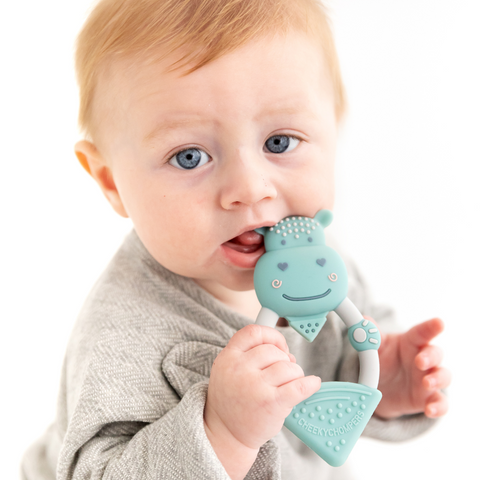Teething is a natural process that all babies go through as they grow and develop. While teething can be a very exciting and rewarding milestone for both parents and infants, it can also be a challenging and uncomfortable time for babies (and you!).
One common side effect of teething is a rash that appears on the skin around the mouth, chin, and cheeks. This is known as a teething rash and it can be a source of concern for many parents and carers.
Teething rashes are caused by the increased drooling that occurs during the teething process. As babies start to produce more saliva, it can irritate the skin and cause a rash to develop. The rash may also be caused by the constant sucking and biting that babies do as they try to relieve the discomfort of teething.
Find out more tips and remedies to help soothe teething troubles, check out our Teething Survival Blog.
The good news is that teething rashes are usually not a cause for concern and will typically go away on their own within a few days. However, there are a few things that you can do to help soothe the rash and reduce the discomfort for babies.
1. Keep the area clean and dry: Make sure to regularly clean the affected area with a soft, damp cloth and allow it to air dry. This will help to remove any excess saliva and prevent the rash from getting worse.
2. Apply a gentle cream or ointment: Using a cream or ointment, can help to soothe the skin and reduce irritation. Try rubbing a small amount of coconut oil on your baby’s chin periodically, it’s 100% natural and can also provide a ‘barrier’ to all the excess dribble that your baby produces during teething. Just be sure to use a small amount and avoid getting it in baby's mouth.
3. Offer a cold teether: Cold temperatures can help to numb the gums and reduce the discomfort of teething. Providing a cold teether or a chilled washcloth for your baby to chew on can be a great way to provide some relief. Cheeky Chompers’ Animal Teethers can be put in the fridge for a cold soothing chew.
4. Avoid using products with alcohol or fragrances: These ingredients can be drying and irritating to the skin, so it's best to avoid using them on a teething rash.
5. Keep your baby hydrated: It's important to make sure that your baby is getting enough fluids, especially if they are drooling more than usual. This will help to prevent the skin from becoming too dry and irritated.

In most cases, a teething rash will resolve on its own within a few days. However, if the rash appears to be getting worse or if it is accompanied by other symptoms, such as fever or difficulty swallowing, it's important to consult a healthcare provider. They can help to determine the cause of the rash and provide appropriate treatment.
Teething can be a challenging time for both babies and parents, but with some basic care and patience, it's possible to manage a teething rash and help your baby feel more comfortable.
For more advise and remedies to help combat teething troubles, check out our Teething Survival Blog.